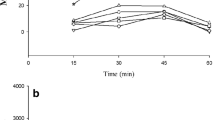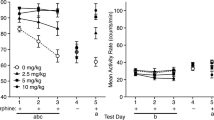Abstract
The role of central versus peripheral opioid receptors in mediating the aversive effects of opioids was examined by use of an unbiased place preference conditioning procedure in rats. The non-selective opioid antagonist naloxone (NLX) produced conditioned aversions for the drug-associated place after subcutaneous (SC) as well as intracerebroventricular (ICV) administration. Place aversions were also observed in response to the ICV administration of the selective μ-antagonist CTOP. In contrast, the selective δ-antagonist ICI 174,864 and the selective κ-antagonist norbinaltorphimine (nor-BNI) (ICV) were without effect. Place aversions were also produced by central applications of the selective κ-agonist U50,488H and the dynorphin derivative E-2078. For those opioid ligands tested, the doses required to produce place aversions were substantially lower following ICV as compared to SC administration. These data confirm that κ-agonists and opioid antagonists produce aversive states in the drug-naive animal and demonstrate that this effect is centrally mediated. Furthermore, the ability of NLX and CTOP, in contrast to both ICI 174,864 and nor-BNI, to produce place aversions suggests that the aversive effects of opioid antagonists result from the blockade of μ-receptors.
Similar content being viewed by others
References
Bals-Kubik R, Herz A, Shippenberg TS (1988) β-endorphin-1(1–27) is a naturally occurring antagonist of the reinforcing effects of opioids. Naunyn-Schmiedeberg's Arch Pharmacol 338:392–396
Bechara A, van der Kooy D (1985) Opposite motivational effects of endogenous opioids in brain and periphery. Nature 314:533–534
Bechara A, van der Kooy D (1987) Kappa receptors mediate the peripheral aversive effects of opiates. Pharmacol Biochem Behav 28:227–233
Bechara A, Zito KA, van der Kooy D (1987) Peripheral receptors mediate the aversive conditioning effects of morphine in the rat. Pharmacol Biochem Behav 28:219–225
Brown DR, Goldberg LI (1985) The use of quaternary narcotic antagonists in opiate research. Neuropharmacology 24:181–191
Cappell H, LeBlanc AE, Endrenyi L (1973) Aversive conditioning produced by psychoactive drugs: effects of morphine, alcohol, and chlordiazepoxide. Psychopharmacology 29:239–246
Chavkin C, James IF, Goldstein A (1982) Dynorphin is a specific endogenous ligand of the κ-opioid receptor. Science 215:413–415
Cotton R, Giles MG, Miller L (1984) ICI 174864: a highly selective antagonist for the opioid delta receptor. Eur J Pharmacol 97:331–332
Magnan J, Paterson SJ, Tavani A, Kosterlitz HW (1982) The binding spectrum of nacrotic analgesic drugs with different agonist and antagonist properties. Naunyn-Schmiedeberg's Arch Pharmacol 319:197–205
Mucha RF, Iversen SD (1984) Reinforcing properties of morphine and naloxone revealed by conditioning place preferences: a procedural examination. Psychopharmacology 82:241–247
Mucha RF, Herz A (1985) Motivational properties of kappa and mu opioid receptor agonists studied with place and taste preference conditioning. Psychopharmacology 86:274–280
Olds ME (1982) Reinforcing effects of morphine in the nucleus accumbens. Brain Res 237:429–440
Paxinos G, Watson C (1982) The rat brain in stereotaxic coordinates. Academic Press, Sydney
Pelton JT, Kazmierski W, Gulya K, Amamura HI, Hruby VJ (1986) Design and synthesis of conformationally constrained somatostatin analogues with high potency and specificity for μ opioid receptors. J Med Chem 29:2370–2375
Portoghese PS, Lipkowski AW, Takemori AE (1987) Binaltorphimine and nor-binaltorphimine, potent and selective κ-opioid receptor antagonists. Life Sci 40:1287–1292
Shippenberg TS, Herz A (1986) Differential effects of μ- and κ-opioid agonists on motivational processes. NIDA Res Monogr 75:563–566
Shippenberg TS, Bals-Kubik R, Herz A (1987) Motivational properties of opioids: evidence that an activation of δ-receptors mediates reinforcing processes. Brain Res 436:234–239
Spyraki C, Fibinger HC, Phillips AG (1982) Dopaminergic substrates of amphetamine-induced place preference conditioning. Brain Res 253:185–193
Stolerman IP (1985) Motivational properties of opioids: evidence on the role of endorphins in mediating reward or aversion. Pharmacol Biochem Behav 23:877–881
Tachibana S, Oshino H, Arakawa Y, Nakazawa T, Araki S, Kaneko T, Yamatsu K, Miyagawa H (1987) Design and synthesis of metabolically stable analogs of dynorphin-A and their analgesic characteristics. Symposium, Tokyo
Takemori AE, Portoghese PS (1988) Pharmacologic characteristics of nor-binaltorphimine (nor-BNI), a highly selective kappa opioid receptor antagonist. Proc INRC, Albi, France
Takemori AE, Ikeda M, Portoghese PS (1986) The μ, κ and δ-properties of various opioid agonists. Eur J Pharmacol 123:357–361
van der Kooy D, Mucha RF, O'Shaughnessy M, Bucenieks P (1982) Reinforcing effects of brain microinjections of morphine revealed by conditioned place preference. Brain Res 243:107–117
Von Voigtlander PF, Lahti RA, Ludens JH (1983) U-50, 488H: a selective and structurally novel nonmu (kappa) opioid agonist. J Pharmacol Exp Ther 224:7–12
Author information
Authors and Affiliations
Rights and permissions
About this article
Cite this article
Bals-Kubik, R., Herz, A. & Shippenberg, T.S. Evidence that the aversive effects of opioid antagonists and κ-agonists are centrally mediated. Psychopharmacology 98, 203–206 (1989). https://doi.org/10.1007/BF00444692
Received:
Accepted:
Issue Date:
DOI: https://doi.org/10.1007/BF00444692




